An Interview with Moonrock Labs
In recent years the concept of the metaverse has exploded in popular imagination. Much of this has been hype focused on a future world where everyone is wearing a virtual reality headset.
The reality is the metaverse has been an evolving concept for years. DFC Intelligence has published several reports looking at the history of the metaverse in video games going back to the 1990s. Our latest reports and PC and console game forecasts look to quantify the impact of the metaverse in today’s market.
So, what is the metaverse when it comes to the current video game industry? Essentially, it refers to games that stand as their own independent platforms. These games take on a unique form, operating as ongoing services that can host various experiences, events, and even serve as promotional avenues for other products beyond the core gaming experience.
Individual games now have an established audience in the tens of millions. Furthermore, this is an audience whose demographics and interests are well understood thus making them an excellent target for advertisers. To get a better understanding of how this concept of the metaverse currently works, DFC talked with Moonrock Labs.
Moonrock is an agency that specializes in creating custom events and experiences for brands within the metaverse. These are interactive experiences that occur within popular games such as Fortnite, Roblox, Minecraft and other products with an established audience. Moonrock is a perfect example of the metaverse in action.
Moonrock has already had many success stories. As just one example, at the VidCon event last month, Moonrock worked with MilkPEP (Milk Processor Education Program) to promote a live-streamed tournament featuring the custom game Zany Ziplines within the Fortnite battle royale. This is part of Milk’s efforts to develop games for the gaming community.
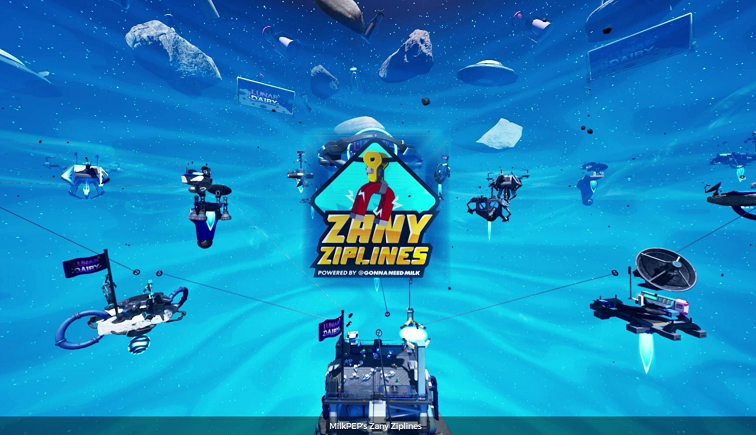
So give us a high level of Moonrock. When were you founded? What is your mission?
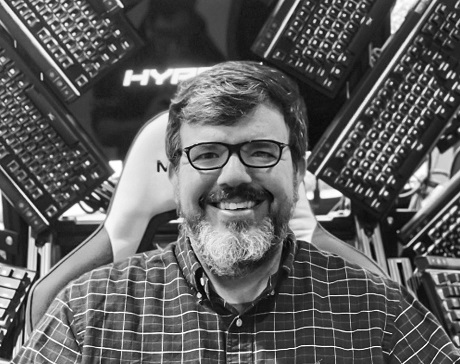
John Gaudiosi, co-founder of Moonrock Labs – Moonrock was founded in 2021 as an agency comprised of former game journalists and community website strategists with the mission of connecting game makers, hardware companies, non-endemic and endemic brands with today’s gaming audience. We bring over 5 decades of experiences from the front lines of game community messaging to the table.
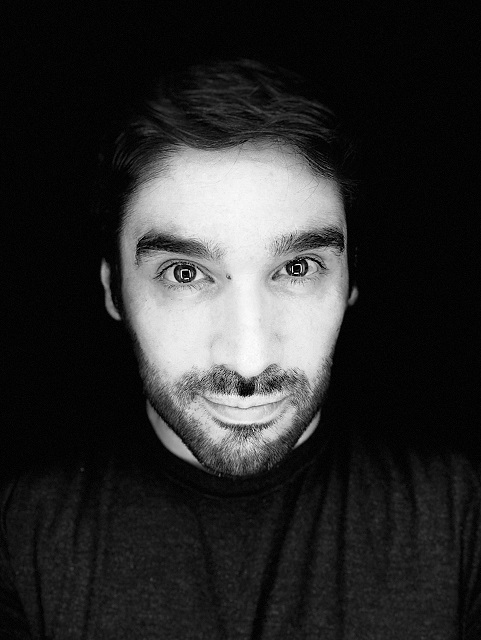
John Benyamine, co-founder of Moonrock Labs – We then brought Moonrock together with EVNT to create Moonrock Labs in 2022, bringing a history of developing games in Minecraft, Roblox, and Fortnite under one house. We’ve since added everything from AI video to spatial computing thanks to our 150-person development team.
Jordan Baker, co-founder of Moonrock Labs – Our mission is to reshape the way that customers interact with their favorite brands. We see a world where users can engage with their favorite products in a three-dimensional way that is not limited to paid text ads and videos. We create gaming worlds that turn brands’ customers into communities by using a gamer-first approach that insures the community will enjoy the branded experience.

Much of what you do is events and experiences within games like Fortnite, Roblox and Minecraft. Do you consider those products a precursor to what is evolving into the metaverse? Are they early experiments, video games with a metaverse component, or full-fledged metaverse experiences?
Krishna Singh – Moonrock specializes in developing within these games because they truly were the first full-fledged metaverses. If you look at the definition of what a “metaverse” is, it’s defined as a “virtual space where users interact with a computer-generated environment with other users”. All three of those games fit that description, with worlds being developed, characters and avatars being customizable, and the ability for players to play & interact with each other.
Jordan Baker – Contrary to what most believe we see the games mentioned as the metaverse. Our version of the metaverse is a space where people from all across the world can communicate and interact with one another in real time. We do not limit the concept of a metaverse to just VR components. It is safe to say that games like Minecraft, Fortnite, and Roblox are not the final iteration of what the metaverse will truly be. I also do not think we should classify these games as “experiments” in the space. They check all the boxes (in our opinion) as to what defines a metaverse.
What about projects like Meta’s Horizon Worlds or Decentraland? These seem more designed from the ground up for the metaverse versus being a video game. Do you do any work with those platforms? Are they still searching for a critical audience mass? Is there a difference between a traditional gamer audience versus consumers engaged in a general VR type experience?
Krishna Singh – Projects like Horizon Worlds or Decentraland are designed from the ground up to be “metaverse” experiences, rather than games, you are correct. However, when you take a deeper look at the numbers backing these projects, it’s very easy to realize that these are projects that are a joke within the community and are simply not what users want. Meta’s Horizon Worlds has less than 200,000 monthly active users, and Decentraland has a staggering 38 daily active users. Roblox in comparison has 43.2 million daily active users. While we can work on these platforms, it often is never something we pitch as there is little value from them to the brands we work with. Traditional gaming audiences want well designed and enjoyable experiences, which general VR does not provide.

Jordan Baker – What separates Moonrock Labs from other studios is that we are gamers. We know that the general gaming community will more than likely not be participants in the Sandbox ecosystem. We also know that VR will not be replacing a PC or gaming console anytime soon. If there is a brand that we feel would benefit from being on those platforms we would provide them with the insight to make those decisions and build them out. However, we know that at this point in time the data shows us that most brands will receive a much higher ROI in games like Minecraft, Fortnite, and Roblox.
John Gaudiosi – With so many companies building out Metaverses today, the landscape of tomorrow is still evolving and undefined. But brands need to ask themselves if they’re just looking to spend Metaverse marketing dollars for a few PR stories, or do they actually want to engage with millions of gamers in an authentic way. Fortunately for empty Metaverses like Horizon Worlds and Decentraland, there are many agencies convincing brands that PR stories are indeed more important than actually interacting with consumers. But our focus is on the big Metaverse games that will drive ROI and KPI while establishing a long-term playground that can grow over time.
Moonrock focuses on bringing brands into the metaverse in compelling, cost-effective ways. The metaverse was a hot topic during 2022 but now it seems to be all about AI. Do marketers still care about the metaverse? Have you seen signs of scaling back?
Krishna Singh, co-founder of Moonrock Labs – In 2023, I have only seen signs of growth, with the tools provided by gaming platforms becoming more powerful. Publishers like Epic Games have moved towards a revenue split model with their Fortnite creators, with marketers seeing the actual games themselves earn revenue based on how many players join, rather than relying on value based on impressions & off platform conversions. While AI is a new hot topic for VCs and tech companies looking to increase cost efficiency, it does not have the marketing & conversion ability for brands that metaverse experiences do.
John Benyamine – Moonrock Labs does stay on the cutting-edge of technology and we currently are working with AI social media creator James Gerde to bring unique viral social experiences to brands. We’ve even announced the start of development on Apple’s new visionOS platform for Apple Vision Pro.
Jordan Baker – When looking at data it is clear that the gaming populus is increasing by massive margins year over year with no signs of slowing down. This can be attributed to more cost-effective means of development, and a lower barrier to entry to get into gaming. Mobile devices, PCs/PC parts, consoles, ETC have all decreased in price over the last few years making it easier for gamers to join the “metaverse”. When looking at how AI affects marketing its clear that the writing and organizational oriented processes can now be expedited. However, an AI cannot create the sort of custom experiences that we create nor provide the white glove services that we offer to our clients. We see AI as a tool that has actually helped propel our clients further into the metaverse as we are seeing the impact of AI pushing clients to invest more into the overall tech/gaming space as a means of marketing.
You have access to a full development team. Can you give us some examples of experiences you have built for clients. How long does a typical project take? What is the cost? What’s the duration of the average activation – are these two-hour events or days/weeks-long happenings?
Jordan Baker – Given that we create fully custom activations for brands it is difficult to give a one size fits all answer when talking about timelines. Generally speaking, most of our projects can take anywhere from one month to 6+ months. This is vastly dependent on the mechanics of the game itself and the type of activation. For example, we built out a custom world for X-Games in Minecraft in less than four weeks. We have also created three custom maps in Fortnite for Milk that have taken us about eight weeks to complete and release. There are some games that can take us much longer though. For example we have built a MOBA game in Minecraft for Twitch to be unveiled at the 2022 “TwitchCon San Diego”. This took us about eight months to create, test and launch. When looking at these examples in terms of mechanics the Minecraft MOBA game has significantly more gaming mechanics that needed to be built, tested, and implemented.
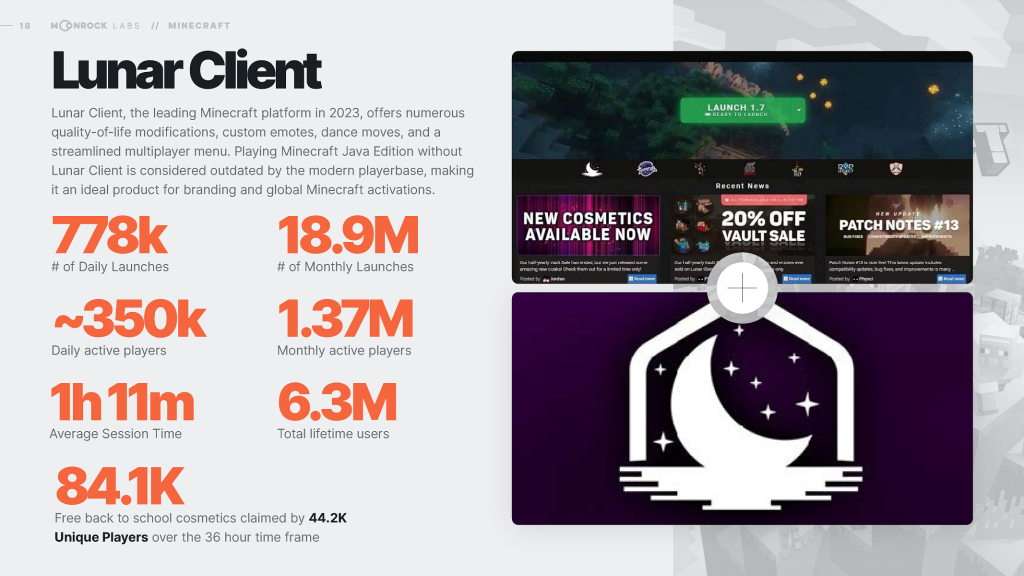
John Benyamine – We have access to 150 developers across Unreal Engine, Java and Roblox, which gives us full control over the experiences we create. There are many agencies that have to farm out all of their projects, which means they don’t have full control over the final experience. This shows why so much good money has been poured into less-than-ideal experiences that we’ve seen from companies as large as one of the biggest retailers in the world. Anything we create we have full confidence in and complete creative control, so we strive for the most compelling experiences that have an extremely long shelf life, unlike those other activations.
So Fanta, Burger King, Macy’s, and Pringles are some pretty big brands. What can they expect from a Moonrock project? How many consumers are interacting with the brand? How are they interacting?
Jordan Baker – We are extremely grateful for the chance to work with such iconic brands. Our clients can expect to receive round the clock communication and a true “white glove” service. We pride ourselves in our studio to client communication and attribute this to much of our repeat customers.
As for players, they interact with these brands in a multitude of ways. A great example of the type of engagement a brand can expect is what we did for Pringles. We created a single month event Minecraft and a Pringles discord server. During this month players created thousands of memes declaring Pringles was better than its competitors. Players streamed themselves racing one and others to see who could eat a can of Pringles the fastest. Community members shipped boxes of Pringles to one another and made Tik-Toks of their reactions. It was a blast! All this resulted in hundreds of thousands of dollars worth of additional promotion for Pringles.
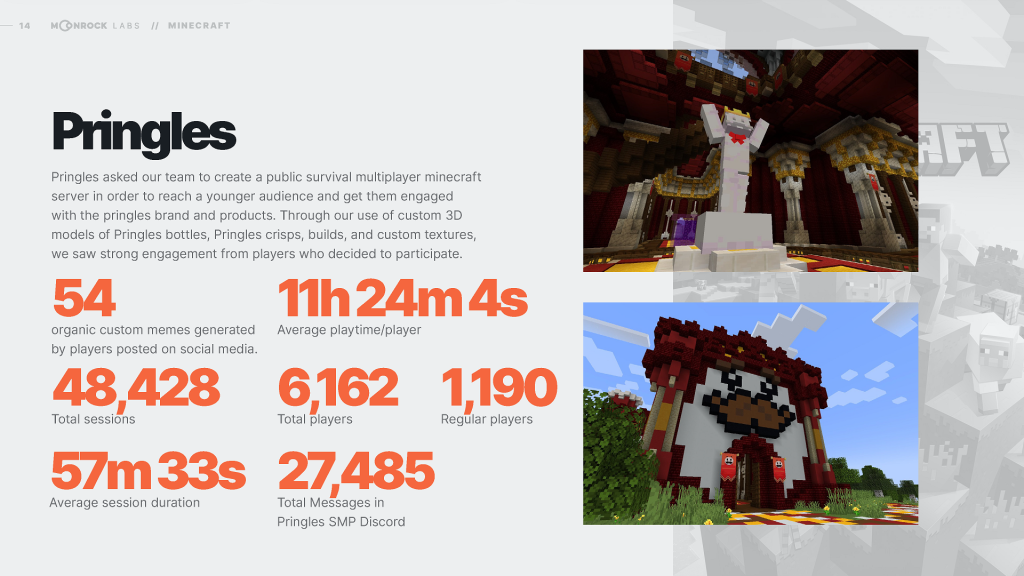
Are marketers still in the experiment phase or are they actually looking at this as a major part of their budget? Do most of your clients have a specific “metaverse budget”?
Jordan Baker – From our experience marketers are dedicating larger and larger budgets to the type of experiences that Moonrock creates. We have seen that the majority of our clients are classifying these gaming expenses as part of their marketing budget. It is easy to see the added value in building a playable branded world that will last forever VS a promoted tweet that will be ignored by most and will disappear off the timeline within weeks.
With the launch of new monetization means for these games we have entered a new age of marketing. Our games can actually now turn a profit for our clients. This has been a super compelling addition to our clients as they are now not just throwing money at the wall and hoping it sticks. They get a truly one of a kind gaming experience that is catered to them and their customers that is now also a piece of IP that they own and can generate additional revenue.
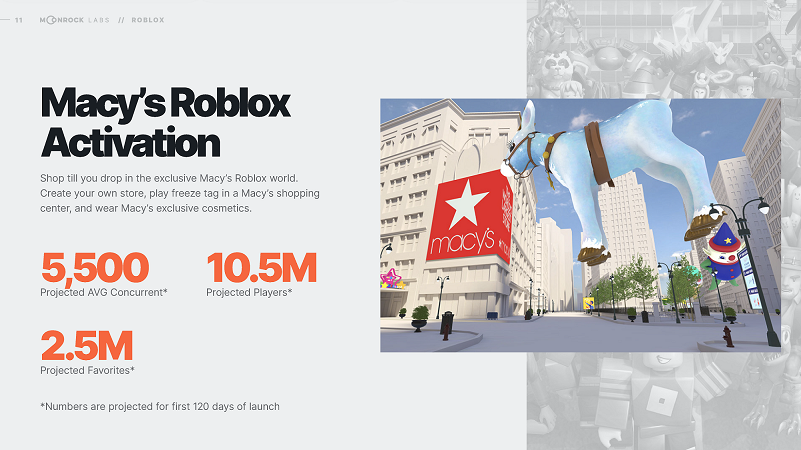
What are the differences between various products such as Fortnite, Roblox and Minecraft when it comes to creating massive, interactive events? How do the projects differ by both the audience demographic and the way the consumers interact with those core products?
Jordan Baker – When it comes to each of these games you not only have to consider the demographic differences but also the players desires. Depending on the brand and what their identity is we tailor the experiences to meet those demands. For example, if we had a lifestyle brand and created a simulator type experience in Minecraft it would perform terribly compared to us building this game in Roblox. You have to understand the nuance that each game has from its play style to its community and even consider the development style.
Do most of your projects offer incentives and/or a way to capture user information? Are coupons, contests, loyalty programs etc. a key component in your campaigns? Do users generally have a way to sign up for future campaigns? I assume users would need to opt-in but that seems a great way to build an audience for future campaigns.
Jordan Baker – We encourage our clients to offer incentives as a means of further promoting the campaign. This can be in the form of physical giveaways, cash prizes, travel, and branded custom products. We do our best to encourage clients to have us create a community discord server so that any future events/games that they create will have a pre-existing and excited community ready to immediately engage.
How much work is done on analytics, both before, during and after an event? Do your clients bring specific usage metrics to the table as part of an ROI formula?
Jordan Baker – We are a data driven company that takes a deep dive into many data points prior to development. We often request more data from our clients than they originally came to us with. We track a myriad of KPIs from engagement, player data, onboarding/offboarding/ sales/ and social reach. This is all to ensure that our clients are more than satisfied with the results from our activities.
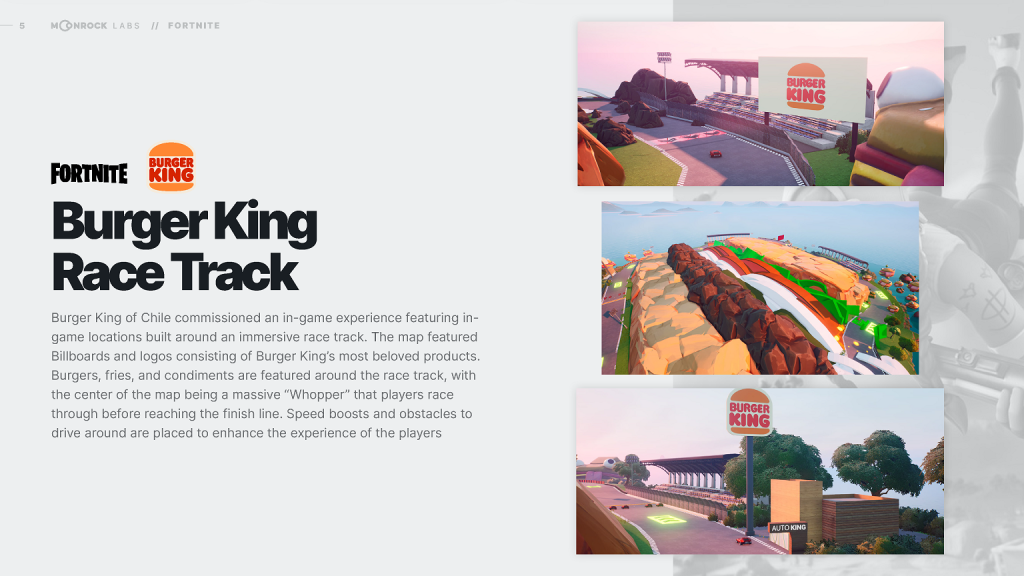
There are lots of companies and agencies targeting this space. What makes Moonrock unique. Who are your primary competitors?
Jordan Baker – We don’t view “competitors” the same way as most industries. In fact we have great relationships with a majority of our “competitors” (GameFam, Wonderworks, ETC). What separates us is that we are not a several hundred million dollar organization. We have a team of nearing 200 staff like our competitors but since we do not have venture capital backing us we are able to move a lot more fluidly, offer far more competitive pricing, and be very hands on with every aspect of the activation. As owners we know where every project is on the timeline at any moment and this allows us to create a product that is built with far more attention.
Virtual goods and NFTs are a way to directly generate revenue from consumers. However, for a consumer brand it seems like it would be a balancing act between wanting to promote the brand versus making a quick buck from selling digital goods. What portion of your projects focus on getting consumers to buy virtual items?
Jordan Baker – Every activation we do is different in this way. We take a look at not only the game style but also the needs of our clients. Some clients push to give away cosmetics, others it makes more sense to provide players with a series of free cosmetics as well as “premium” cosmetics that are pay walled. The paid items are typically more custom and unique to the brand. We make the paid items desirable to the players so that they feel adequate value in the transaction when purchasing these products.
How much of your work is on tournaments, conventions and esports style events? At TwitchCon you did a Minecraft esports style event. What was that about? Minecraft is not normally considered a competitive product. What else have you done with Minecraft?
Noah Barskiy – Most creatives in the Minecraft modification scene see Minecraft more as an engine than a game itself, where imagination dictates the product. I’ve seen Minecraft turned into a space exploration game, an archaeological dinosaur game, and sometimes, a competitive game. Minecraft is a deceptively difficult game to master, so we have a lot of fun turning it into a competitive format! As an example, we made a MOBA game within Minecraft, based around popular mechanics in League, DOTA, Smite, and more. We’ve also created various custom Capture The Flag, Team Deathmatch, and Battle Royale formats, which always lead to a healthy competitive environment.
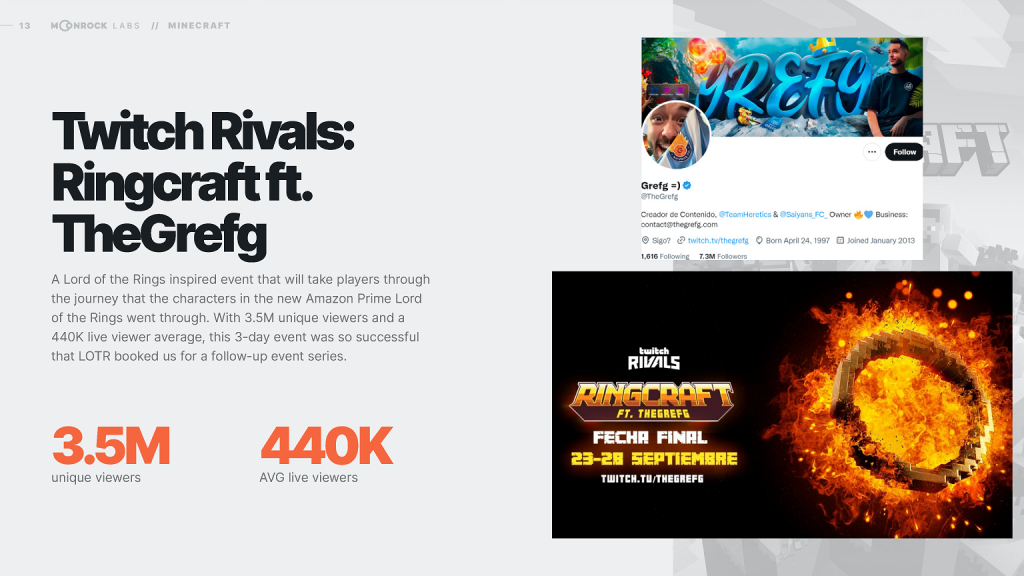
Do companies doing projects for events also tend to look to do a long-term playable experience to showcase their brand? In other words, does it (or will it) become part of a major campaign where a brand creates experiences across multiple games/metaverse properties and also ties those into one-off specific events? Are there any examples of major brands committing to an in-depth metaverse strategy?
Jordan Baker – We encourage brands to create long term activations in the form of “Forever Experiences”. While yes these games have a larger upfront cost the client receives far greater value by owning a piece of IP in perpetuity that can generate revenue for the brand. We like to use the example of renting a home and buying it outright. Sure a short term activation as an event or tournament makes sense for some clients but it is always better to outright own the game in the long run. The TLV of these games can in theory pay for themselves all while giving the brands a digital footprint that is sustainable and can grow with the brand.
Do you foresee a near future in which Moonrock virtual events are complemented by real-world events and gatherings, and/or augmented reality Moonrock events that combine the real world with a virtual world or virtual content?
Jordan Baker – This is already happening. We are seeing our clients come to us and asking us to build a virtual world that is complemented by an IRL activation. This is a great way to boost the brand’s visibility and is incredibly impactful. This gives the brands the chance to live in both spaces and bring everyone together as a critical mass. This can also create “superfans” much more efficiently as you are able to meet your customers/community face to face and engage with them in a real human interaction. This is great for building a base of users to push your digital activation so much further.
John Gaudiosi – A great example of this is at VidCon in Anaheim where we’re building out a booth and stage on the show floor and producing a livestream filled with influencers who will be playing the new Milk Fortnite maps that we created. We also built portals across popular Fortnite maps to drive awareness. And we’re running media ads to let everyone know they can play these new maps for free.
As a final question we always like to look at the bigger picture of the future of the metaverse. A common accepted definition of the metaverse cites seven core attributes/properties that metaverse projects will eventually try and strive for. These are:
- be persistent
- be synchronous and live
- be capable of accommodating any numbers of users, while giving each user an individual sense of ‘presence’
- be a fully functioning economy
- be an experience that spans both the digital and physical worlds
- offer expansive interoperability
- be populated by content created by a large number of contributors
Obviously, this is a long-term future wish list that will take most projects years to reach. However, some companies are closer than others. How many of these attributes do Moonrock projects feature and if you could magically add one of the other criteria to your current toolset, which would you choose?
Jordan Baker – As of now Moonrock has the ability to check all of these boxes with any of our activations. The one that is a bit more difficult to create for every client is the physical world. We are able to create digital triggers in the physical world but not all clients are at this point in time able to be in both. This costs a lot of money and overall has far less of an impact as staying in solely the digital space. While we encourage all of our clients to couple the digital experiences with a physical activation there are so many ad dollars that can be spent.
John Gaudiosi – The one element we have for the physical world element is our relationships with some of the top pop culture conventions in North America, including San Diego Comic-Con, VidCon, LA Comic Con, WonderCon, SuperCons, and Fan Expos. This gives us a calendar of IRL events with hundreds of thousands of people that can intersect with custom Metaverse experiences across Minecraft, Fortnite and Roblox.

